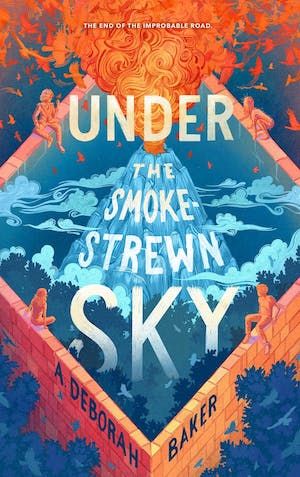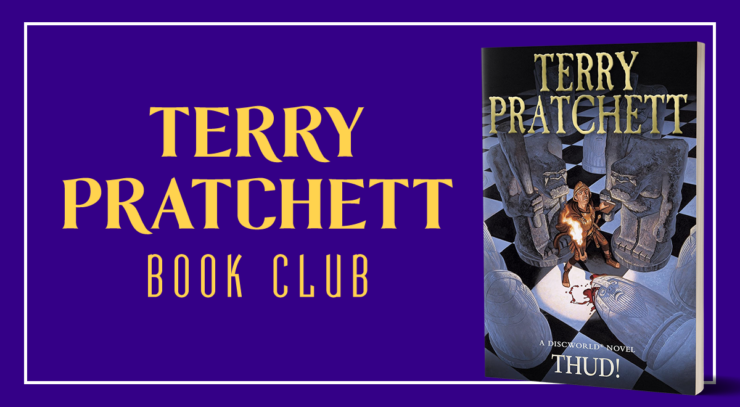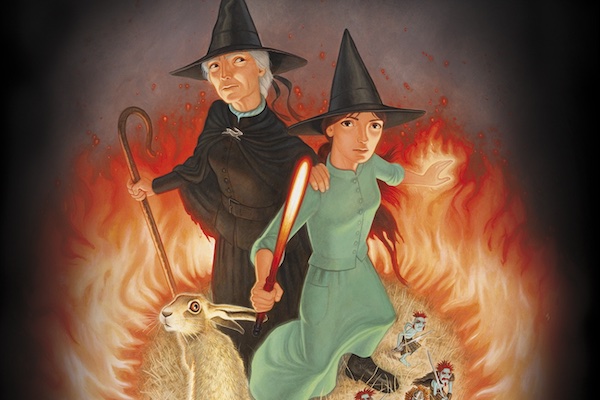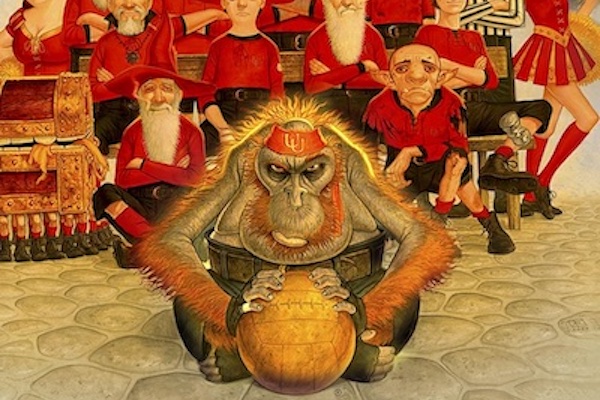Vimes doesn’t much care for the game the book is named after… wonder if that’ll be relevant somehow.
Summary
There are historical texts and translations around early dwarf and troll cultures. And then a murder, witnessed by a troll. Sam Vimes is shaving himself and Willikins is reading out the important bits from the Times, one of them being the current “dwarfish situation” and the other being a piece about how the Watch is going to be interviewing a vampire. There has been a murder beneath the city and all the dwarfs who have come across the body agree that no one should speak of it, and also that it was committed by a troll. Vimes has a waiting mob at the Watch House to protest the potential appointment of a vampire while Otto is standing there to take pictures. Cheery has been promoted to sergeant and got Angua to bring the vampire interviewee in through the back, which has Vimes worried given the tension between vampires and werewolves. Angua is having difficulty with the vampire, one Sally von Humpeding, but shows her around. In the meantime, Vimes has to deal with a city inspector named Mr. A. E. Pessimal, who refuses to call him anything but “Your Grace.” Pessimal asks for an office and tells Vimes that he’ll need to interview officers. Fred has been moved over to custody officer at the Old Lemonade Factory and tells Vimes that he’s hearing things on the streets from the dwarfs, who seem tetchy, and has seen troll graffiti about someone called Mr. Shine.
Buy the Book


Under the Smokestrewn Sky
Vimes reads up on Koom Valley, an old fight between dwarfs and trolls that made their mutual hatred “official.” Saturday is Koom Valley Day, and it’s more tense than usual since Grag Hamcrusher arrived a month ago and started preaching that dwarfs were superior and it was their duty to wipe trolls from the earth. Vimes breaks up a fight in the canteen between dwarf and troll officers and tells everyone to get to their jobs and not mess about. He has to go interview Sally, then, which gets off on the wrong foot when he mentions it to Angua, not noticing that Sally is behind her. Fred and Nobby are walking along elsewhere, and Fred mentions that he met Nobby’s current girlfriend… at a local strip club. Fred thinks this isn’t appropriate, but Nobby is quite taken with Tawneee. The curator of the Royal Museum of Art stops them in the street to let them know that a famous painting—The Battle of Koom Valley—has been stolen. They find that it’s been cut out of its frame, and learn about the painter, who worked on the piece for over fifteen years while he was poor and constantly moving about and maybe going a bit mad. People believe that there’s a secret hidden in the painting, but no one can agree what the secret is, and there’s a book for those interested in the mystery: The Koom Valley Codex.
Vimes does his interview with Sally, which doesn’t go well, but he decides to hire her anyway on probation. As they’re finishing up, Carrot bursts in to tell him that someone’s killed Grag Hamcrusher. Vimes learns that the dwarfs were planning on keeping all this a secret and that Carrot only found out because one of the dwarf officers is keen on being promoted. Vimes knows that this is sensitive, but he wants to drop by to ask after Hamcrusher and at least try to confirm if the murder is true. The deep-down dwarfs are wary of Carrot and Cheery, but Vimes insists on bringing Detritus in his crew regardless. On the way, he’s reminded by his new Dis-Organizer that he’s meant to sit for a family portrait, and has to send an officer to give Sybil his regrets (again). They arrive in the street and Angua can feel a thudding below, shaking the area. Vimes tells the guards at Hamcrusher’s house that he wants to see the dwarf and is told he’s not seeing anyone; knowing that he’s dead, Vimes asks the guards to ask someone in authority what should be done next—or he plans to bring Dorfl in to break the door down. They try to wait him out, but finally have to let him in with Angua. Eventually, they are greeted by a dwarf called Helmclever, who is the “daylight face” of this group.
Vimes finds that he has a copy of The Koom Valley Codex and demands that Helmclever let him see Hamcrusher’s body. Someone new emerges named Ardent, and Vimes and Angua are both brought to his office. He admits that Hamcrusher was murdered and insists that they are handling the issue. He also insists that a troll committed the crime because a troll’s club was found by the body. Vimes tells him that this is absurd and demands to see the other grags. Ardent insists that they won’t speak to him, that his joke to the Low King in Uberwald about being a blackboard monitor is a crime to true dwarfs—Vimes erased words. Vimes tells Ardent that if he won’t allow it, they’ll essentially be declaring war against the city, so Ardent agrees to take him. As they’re heading down, Vimes gashes his hand on a nail or rivet. Far off, a troll named Brick who is frequently high on Scrape vaguely remembers wandering into a hole and it turning out to be a dwarf place. When Vimes emerges from the mines (having gotten access to the crime scene for Carrot), a bystander throws a brick at dwarf officer Ringfounder; Detritus catches the brick-throwing dwarf and they arrest him. Heading back to the Watch House, Otto is there and ready to get a picture of Detritus holding the dwarf in the air. Carrot tells Vimes that the symbol he saw Helmcleaver draw in coffee is a reference to “The Following Dark,” which is… not good.
Commentary
This story is deceptively layered, when you get right down to it. It’s about prejudices and racism (or the allegorical fantasy equivalents), but it’s also about Sam Vimes’ own issues with control and how a belief in justice might be practiced in manners that are decidedly unjust.
What I’m saying is, it’s incredibly pointed that all of this is happening while the Watch is undergoing a city inspection, that Vimes thinks that said inspection should never be a thing, and that it’s coming on the heels of Vetinari having seen Vimes cross a line where Carcer was concerned in that cemetery in Night Watch. Basically, the Patrician is silently stating in no uncertain terms that Vimes’s claims as the person who watches the Watchmen are no longer sufficient, given the amount of power (and money) they wield. He’s right, even if the audit will turn up more than a fair share of silly concerns. He’s also right that Vimes cannot make his one diehard prejudice a policy within his sector, and that hiring a vampire is important.
But because these stories set no store by black-and-white thinking, the problem of Hamcrusher’s murder is incredibly wooly in all sorts of ugly ways. Large cities frequently have to deal with populations of people who want to create their own mini societies within the confines of those metropolises. The usual bottom line in those scenarios is that if you want to live somewhere with different laws than you’re accustomed to, you have to abide by them. That doesn’t stop some groups from trying to skirt those laws any more than than the general population often does (because that factor often gets left out of the conversation—plenty of folks flout laws, for all manner of reasons).
What Vimes is coming up against—what’s making him angry, and that’s a key factor in this—is that the deep-down dwarfs believe that their own home laws should apply in his home, and that they are acting constantly without any care for the other citizens around them. And while his anger is understandable, particularly where that last bit is concerned, it is still something that should be kept firmly out of his job. He knows that. But knowing it and enacting it are two different things.
Vimes immediately resorts to intimidation in this scenario. And yes, it’s because there has been a murder and he’s right that the dwarfs shouldn’t be allowed to hush it up from everyone else. They certainly shouldn’t be allowed to blame another species on weak circumstantial evidence to stoke racial tensions higher in the city. And it’s also relevant that Vimes tends toward an altogether fairer code than nearly anyone around him—it’s so, so pointed that Carrot is the one who suggests separating trolls and dwarfs on patrols, and that he’s a person who is often considered more good than goodness allows, and that this line of thinking is still entirely wrongheaded. Vimes knows that, too, and never considers following the suggestion because he understands that Carrot’s desire to keep people comfortable at all cost is preventing him from making good recommendations.
But Vimes still sits down on Hamcrusher’s stoop and threatens his people.
He does it in service of justice and he ultimately gets what he’s aiming for and what’s needed—the city finds out for sure that Hamcrusher is dead and he gets Watch access to the crime scene so they can hopefully solve the crime for real. But he still got all of that by amiably chatting with the guards and letting them know that if they didn’t cooperate, he would storm the premises with extreme prejudice using Constanble Dorfl. The use of coercion and intimidation to receive cooperation—even for something as heinous as murder—can only ever be wrong. Claiming to keep the peace by threatening to destroy it on a smaller scale doesn’t math out.
What the deep-down dwarfs are doing is also wrong, though; the way they treat anyone identifying as female as lesser, digging beneath the city without any consideration for the people above (who they barely believe are real to begin with—which is also wrong, no matter your cultural views), blaming a troll for Hamcrusher’s murder. But while the saying “two wrongs don’t make a right” is trite, it’s still getting at an ultimately true point: Trying to fix someone’s wrongs by committing your own is a quick and easy way to begin justifying all manner of atrocities. It’s better not to start.
As a side note, it only just now occurred to me how painstakingly Pratchett describes darkness, almost as an antidote to movie candlelight; we’ve all watched in films and television how one tiny candle can illuminate untold caverns of darkness. It’s sort of similar to how movie fires let you see everything in a room that should be nothing but smoke. Whenever dwarfen spaces are described in these books, whenever you’re in true darkness, the narrative is clear that no tiny amount of light is going to penetrate anything. That picking out details will be impossible and everything will be rendered in the strangest tones of gray and shadow.
Asides and little thoughts:
- “He knew in his heart that spinning upside down around a pole wearing a costume you could floss with definitely was not Art, and being painted lying on a bed wearing nothing but a smile and a small bunch of grapes was good solid Art, but putting your finger on why this was the case was a bit tricky.” Good old Fred, coming in with the classic “I don’t know how to define pornography, I just know it when I see it” argument.
- Obviously all the references to people coming in to measure the painting and puzzle out what it means are in reference to The Da Vinci Code, which had been published a couple years ahead of Thud! and was massively (and somewhat annoyingly) popular at the time.
- Wow, the technology section here being just a gorgeous lesson in obsolescence: Vimes’ next Dis-Organizer is called the “Gooseberry,” now the most hilariously dated Blackberry joke ever made. Bluenose messaging works, however, because Bluetooth is more prevalent than ever. And then there’s iHUM, which… iPods vanished about a decade after this book came out, though iTunes still exists. Wild.
Pratchettisms:
Mr. Pessimal folded himself onto the chair in front of Vimes’s desk and opened the clasps of his briefcase with two little snaps of doom.
Vimes considered the admissibility of Fred Colon’s water as Exhibit A.
Now the melting pot was full of lumps again.
“That is certainly one of the theories,’ he said, speaking carefully, as people tended to after hearing the Colon-Nobbs Brains Trust crossing purposes.
Vimes sighed. He hated games. They made the world look too simple.
On the ceiling above them, vurms congregated, feasting on spittle and rage.
“You talk to bad dreams on their behalf?”
Next time we’ll read up to:
For Brick, everything went dar—












